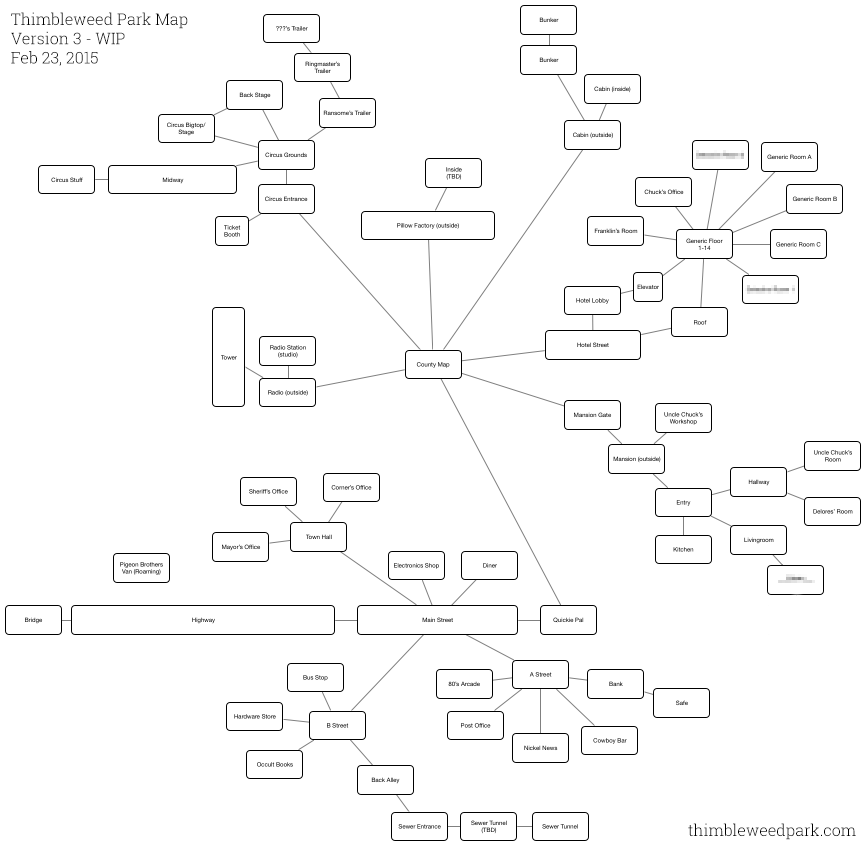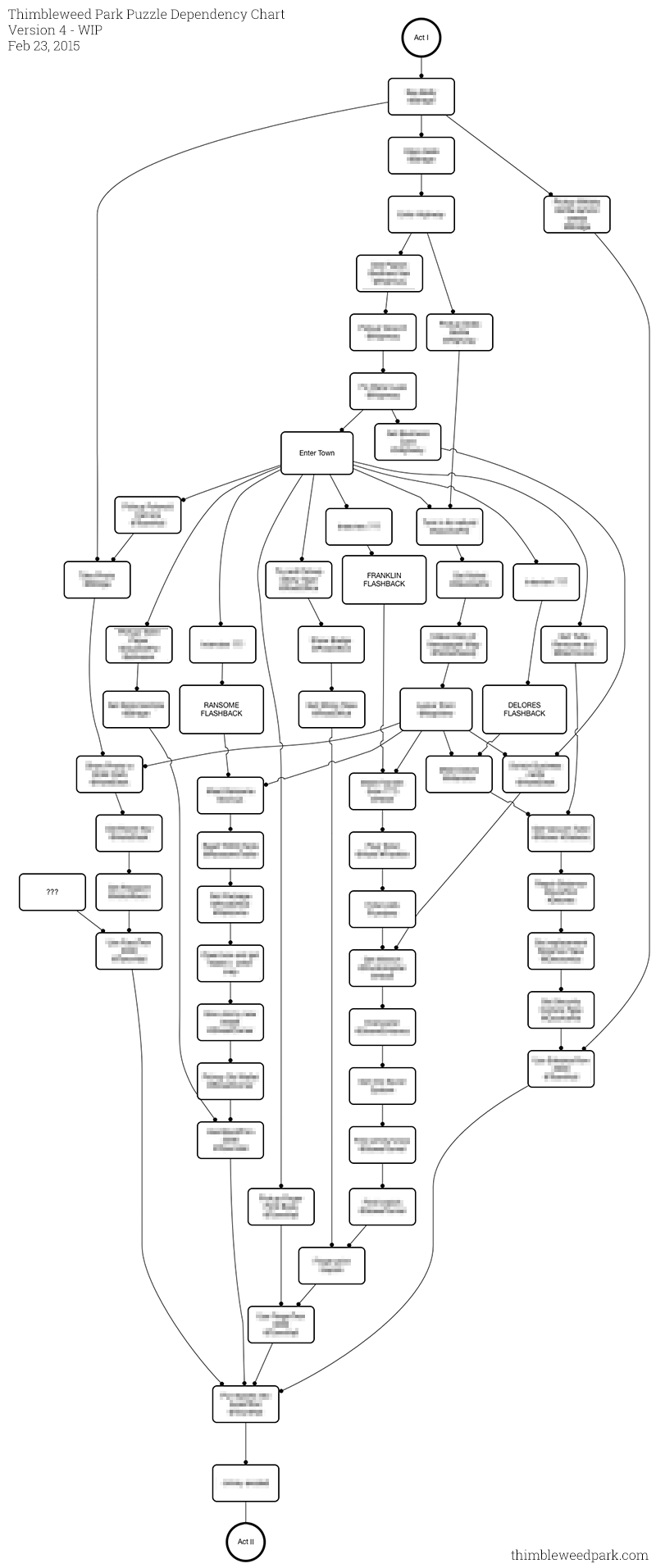More Maps and Puzzles
Feb 23, 2015
It's Monday so it's time for a big fat meaty Thimbleweed Park dev blog update and for today's action packed episode we're going to dive into maps and puzzle dependency charts. These map and puzzle chart refinements are the result of the two-day brainstorm Gary, David and I had last week. I've blurred out anything that could be a spoiler.
First up is a map of the world. We had much of the map figured out for this post, but as the puzzles become more solidified, the map can change with a whirl of additions and deletions. We might come up with a location that sounds fun, but later realize it serves no real purpose so we remove it. The room stays on a list and might come back, but only if we find a good use for it.

Cutting stuff is almost as important as adding stuff. Every room in the game should have a purpose. Most of the time that purpose is to find an object or solve a puzzle. Sometimes rooms exist just as a home to a character needed for story reasons, but that is usually coupled with a puzzle, but not always. Rooms can exist to help define the world, maybe it's an establishing shot or an overlook to help players understand where they are, or to set a mood.
If the room is just something to be traveled through, it should be cut. If the room only has one small purpose, also consider cutting it.
One of my pet-peeves with "director's cuts" of movies is that a lot of those scenes should have been cut and were initially cut for a reason, only to be brought back by marketing departments to sell more DVDs.
Of all the rooms that were cut from Maniac Mansion, Monkey Island, the Humongous games (or most anything I've done), I can only remember a few that were cut because we ran out of time. Most were cut because it made the game tighter and better. Sometimes I've resisted cutting, fought and argued against the cut, only later to find the game better for the loss. Don't be afraid to cut. Cut, cut, cut.
As a perpetual warning to readers of this dev blog: don't get too attached to anything you see here. A lot is going to change over the next 18 (I guess it's 16 now!) months. It's part of the process. Cut, cut, cut.
Next up is the puzzle dependency chart. This looks quite different from the one posted a few weeks ago, mostly because this dependency chart is just Act I, where the other was a small chunk of puzzles from all the acts. The first chart was getting a little unruly, so I started over and began building from the beginning.

I'm really happy with the shape of this chart and by shape I really do mean the shape of it. It has that much sought after diamond shape, starting small, branching out and then pulling in. It means players aren't going to be overwhelmed at the start, then they have multiple puzzles to solve in parallel, then everything pulls and focuses in at the end.
There are a few puzzles not shown on this chart that players will start solving in Act I and not complete until Act II or Act III. There aren't a lot of them, but a few are needed so players can have nice epiphany moments with characters, puzzles or objects they found hours or days ago.
I would estimate this chart represents a little more than a third of the game. Act II should be a little bigger, Act III will be about half this, then the character epilogues (which shouldn't be very long).
Also, this puzzle chart contains three nodes labeled "Ransome Flashback", "Delores Flashback" and "Franklin Flashback". These nodes are the playable flashbacks and consist of small self-contained little adventure games, complete with their own puzzle charts (not shown). Each of the flashback adventures should take about 15 minutes to play and help set up the characters and their backstories. We wanted to do them as "playable" so players didn't have to watch long cut-scenes.
I firmly believe players shouldn't lose control for more than 10 or 15 seconds, maybe 30 at the most (and rarely). Adventure game stories should be played. If I wanted to watch a story, I'll watch a movie, they do a much better job of it.
Last week I focused on design and didn't even crack open Xcode. This week is going to be non-stop programming and the week after is kind-of screwed due to GDC. I mean "screwed" in the good sense. GDC is a lot of fun.
- Ron

Here is a probably stupid question, because I'm attending the GDC, too.
Do you have any free spots available for a 'developer-fans' meeting?
Thisng are starting to take shape, aren't they?
Second best regards, Mattias.OCD
While I have your attention...Since this game is apparently being set in 1987 (or thereabouts), are you going to make it somewhat of a priority to squeeze in as many funny references to the technology back then: "portable" computers, 5 1/4" floppies, speedy dial-up 2400 baud modems, calculator watches, VHS tapes, the dawn of the CD era, the portable cassette player (Sony Walkman), cable TV having SO many channels, the Polaroid instant camera, animatronic teddy bears, etc. I want to TASTE 1987 while I'm playing this game. Kind of like hairspray and Crystal Pepsi. Yum.
I'm not big on pop culture references, but I do find the 80s to have a bizarre mix of fictional product spokesmen- a virtual reality talking head, a surfer dog selling alcoholic beverages, and some dancing and singing dried fruit singing your favorite classics of the 50s.
I wander how you use the dependency charts after you have defined them.
Are them coded inside some "dependencyChart" data structure? If not what is your approach on implementing them into the game?
As I was reading this post I was thinking how it would be pretty cool to have an option for a second play-through of a game like this where you could watch the puzzle dependency chart unfold as you are playing. Do you a display like this for debugging during development?
https://www.omnigroup.com/omnigraffle
http://www.gdconf.com/
Nah... Probably:
Guybrush's Death Cousin
:(
Is it the town or the county that's just available to customers? (like customer toilets) :-D
I hope you get Noah Falstein onboard as well.
Players of the classics have been hoping for something like this for a long time. I must say it feels both fresh and like a long trip down memory lane. Apropos trips. Pssst. ... I loved the "world tours" that brought Zak to most interesting and distant locales all across the world. That was very special... so with TP being a new game in the spirit of Maniac Mansion, most of all, I am hoping it will be a great success. Big enough so maybe, you'd like to make one other game .... in the spirit of Zak McKracken. Let us travel the world again ... running from something, solving a mystery, helping friends, and saving our dear planet earth from another invasion that had been going on in secrecy ;).
I'm just a glutton, I know....
Did Gary draw all of these? Or did you guys each made a self-portrait?
Will these charts be available after the game is released, so that we can see the progression in a documentary fashion?
This is for you 'weeders (that's the official name for residents of Thimbleweed Park, right?) out there who - like me - love to read anything and everything on good game and puzzle design :-)
http://thealexandrian.net/wordpress/1118/roleplaying-games/three-clue-rule
This is severly lacking an edit button
(I can't believe how often I get that Seckrit Question wrong...)
The game still has atmosphere, but it also had glaring issues in the way it was designed. Too many things were designed to just look pretty without any actual function. This slowed the game down and made it feel like more of a chore than a fun experience.
Ron, when some material is cut from the game, and some game assets have already been created for that. Like a half finished room, an inventory object, or maybe even characters. Would it be possible to collect all these strips and bits of cut pieces and collect them somewhere until the game is ready to be released, and then show these cut things off in some way, inside the game, like Extras on a DVD? Maybe with written information or spoken commentary?
I have backed several Projects on Kickstarter but nothing like this before.
My recent Experience with Kickstarter Projects was more like GIVE ME YOUR MONEY AND SHUT UP.
And weeks over weeks you hear nothing at all from them.
If you request an update normally you´ll get not even a response.
But this one shows that it can go a better way then that.
I really like your way of keeping us informed and that you ask us questions :)
Proud to be a baker!
Go on with this great work :)
Big Thanks
Mike
I think we also had that discussion over at the Kickstarter comments section during the campaign :-D